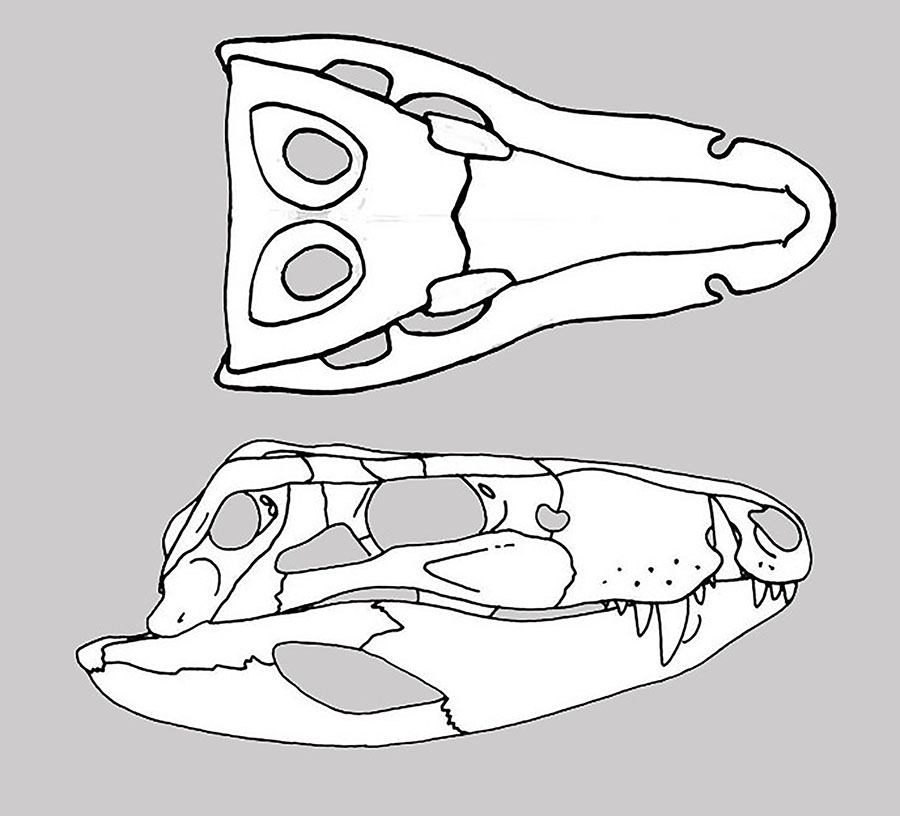
Genus: Campinasuchus SOUZA CARVALHO, ANTUNES TEIXEIRA, FONSECA FERRAZ,
BORGES RIBEIRO, MARTINELLI, NETO, F. M., SERTICH, CUNHA, CUNHAAND FERRAZ, 2011
Etymology: Campina refers to the area where the fossil was found, Campina
Verde County, Minas Gerais State, Brazil and Greek, suchos, referes to the Egyptian crocodile-headed god
Sebek.
Species: dinizorum SOUZA CARVALHO, ANTUNES TEIXEIRA, FONSECA FERRAZ,
BORGES RIBEIRO, MARTINELLI, NETO, F. M., SERTICH, CUNHA, CUNHAAND FERRAZ, 2011
Etymology: In honors of Izonel Queiroz Diniz Neto and the families Diniz and
Martins Queiroz, oweners of the Tres Antas Farm, where the fossil was excavated.
= Campinasuchus dinizi SOUZA CARVALHO, ANTUNES TEIXEIRA, FONSECA FERRAZ,
BORGES RIBEIRO, MARTINELLI, NETO, F. M., SERTICH, CUNHA, CUNHAAND FERRAZ, 2011
Note: Campinasuchus dinzorum = Campinasuchus dinizi; note the authors incorrectly
used the wrong ending for the species, it was named in honor of several familes
and should be -orum not -i)
Holotype: CPP 1235
Locality: Tres Antas Farm, 19°30'47"S, 50°06'20"W, Honoropolis District, Campina Verde County, Bauru Basin, Minas Gerais State, Brazil.
Horizon: Adamantina Formation, Upper Bauru Group.
Biostratiraphy:
Age: Turonia n Stage, Uppermost Gallic Subepoch-Santonian Stage, Lower Senonian Subepoch, Lower Gulf Epoch, Late Cretaceous.
Material: A well preserved posterior skull and partial rostrum (proatlas, pedicles of the atlas, odontoid process and axis articualted to the skull).

Campinasuchus dinizorum (after Souza Carvalho et al. 2011).

Campinasuchus dinizi (modified from Cotts et al. 2017).
Paratypes:
CPP 1234: Partial skull with occluded mandible missing posterior portion of the skull.
CPP 126: Nearly complete rostrum.
CPP 1237: Partial skull and mandible and associated postcranial skeleton (protalas, 4th, 6th, 7th cervical, 5th to 10th dorsal vertebrae, three posterior dorsal vertebrae, two anterior, two posteromedian, and four posterior caudal vertebrae (three terminal), the 2nd cervical rib and six dorsal ribs, two chevrons, and six ostoderms, a fragment of the scapula lamina, one coracoid, the right and left humerus, one carpal (ulnar), the right and left ilium, the ischium and femora, tibiae and astragalus).
Referred material:
COTTS, PINHEIRO, DA SILVA MARINHO, DE SOUZA CARVALHO, & DARIO, 2017.
CPPLIP 1435: The first ten caudal vertebrae articulated among themselves and thier respective chevrons.
CPPLIP 1436: Humerii, radii, ulnae, carpals (ulnar, radial, pisiform and one distal carpal), the metacarpals and manual phalanges, the left tibia without the proximal epiphysis, one fragment of a tarsal (a fibular articular surface fragment), the metatarsals and pedal phalanges.
CPPLIP 1437: The proatlas, gastralia, and six osteoderms, left scapula, fragment of the right coracoid, the left humerus, left scapula, a fragment of the right coracoid, the left humerus, pubis, left tibia and proximal epiphysis of the right tibia and left fibula.
FONSECA, MARTINELLI, MARINHO, RIBEIRO, SCHULTZ & SOARES, 2020
CPPLIP 1319: Snout.
CPPLIP 1360: Nearly complete skull.